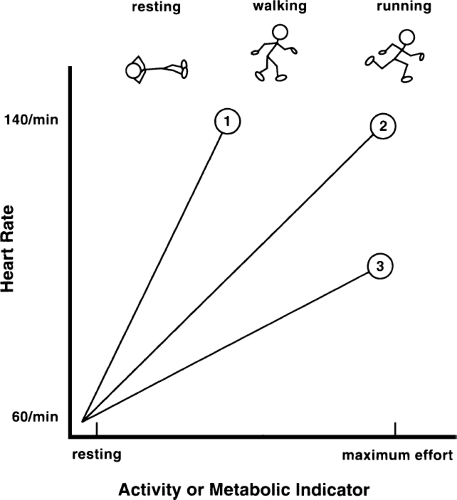Rate-Modulated Pacing
Permanent Pacemaker Application
The concept of rate-modulated (rate-responsive, rate-adaptive) pacemakers is to move beyond simple backup pacing for bradycardias to helping a patient adapt to physiologic stress with an increase in heart rate, even if the patient’s intrinsic sinus node normally would not allow this to occur. The development of dual-chamber pacemakers allows a patient to increase the heart rate if he or she is in sinus rhythm and sinus function is intact. Many patients, however, have sick sinus syndrome that prevents normal physiologic sinus node response to exercise, stress, or chronic atrial fibrillation.
Tremendous gains were made in this area during the 1980s. The approach to rate-modulated pacing can be thought of as having three components:
An indicator, such as activity, body temperature, or respiratory rate, that is an approximate measurement of metabolic needs
A sensor that can measure the indicator (or indicators) chosen
A rate-controlled algorithm that is in the software of the pacemaker and modulates the pacemaker rate as the sensors send signals to the pacemaker (Fig. 8-1)
Indicators
Accelerometer
A piezoelectrode is a quartz-like substance that, when bent, generates electric energy. A flat sheet of piezoelectric material can be placed inside the pacemaker generator. Changes in body movement and muscle motion will cause deformation of the piezoelectrode crystal. That mechanical signal is transferred to an electric signal that is, in turn, routed through sensors, filters, and other electric components, causing the pacemaker to increase its rate, depending on the amount of activity or motion sensed.
Piezoelectrode sensing has generally given way to accelerometer sensors (in combination with piezoelectrode technology).
The accelerometer is a small weight (mass) suspended by wires tied to a frame. When the body (in the frame) moves, the mass remains still until the wires stretch and exert force causing the mass to move, allowing acceleration or deceleration to be transmitted into an electric signal.
A lower rate limit is set in this type of pacemaker to allow a reasonable baseline rate when no activity is sensed. A maximum rate is set for when the pacemaker is sensing considerable motion. A graded ramp is incorporated into the pacemaker software for increased pacemaker rate as increased motion is recognized.
The advantages of this approach are that (a) it is relatively simple and inexpensive, (b) it does not require a special lead, and (c) it detects motion changes easily and there is relatively little energy drain with this approach.
Potential disadvantages of this approach include both false-positives and false-negatives. For example, a patient standing still on a bus on a bumpy road
may tend to trigger the motion sensor even though there is no increased physiologic need for a higher heart rate. Conversely, a patient riding a stationary bike may not trigger the sensor enough to increase the heart rate appropriately. Emotional stress would not be recognized if not accompanied by motion.
may tend to trigger the motion sensor even though there is no increased physiologic need for a higher heart rate. Conversely, a patient riding a stationary bike may not trigger the sensor enough to increase the heart rate appropriately. Emotional stress would not be recognized if not accompanied by motion.
Minute Ventilation (Respiration)
Respiration sensors are available for physiologic pacing and represent a fairly good measurement of metabolic need related to activity or stress. Measuring respiratory rate uses the fact that transthoracic impedance changes with the respiration. The impedance between a pacemaker generator and a reference electrode (see Fig. 8-2) changes with respiratory rates. As the lungs inflate with inspiration, there will be higher resistance (due to more air and less fluid between the electrodes), which can be detected by the impedance sensor.
Measurement of changes in impedance can be used to estimate minute ventilation and pacemaker rate can change appropriately. Having a rate-adaptive pacemaker respond to minute ventilation may have advantages over response to respiratory rate. For example, with exertion, minute ventilation will increase, but if the patient hyperventilates without exertion, the respiratory rate will go up, but often total volume will go down and minute ventilation may remain close to baseline.
Compared with motion sensors, the minute ventilation responds more slowly to activity, but appears to be a useful feature. Ventilation sensing may shorten the battery life by approximately 1 year in some systems. The frequent
spikes can interfere with the electrocardiogram (EKG) (Fig. 8-3), especially transtelephonic measurements, which may accentuate the spikes.
spikes can interfere with the electrocardiogram (EKG) (Fig. 8-3), especially transtelephonic measurements, which may accentuate the spikes.
Stay updated, free articles. Join our Telegram channel

Full access? Get Clinical Tree



